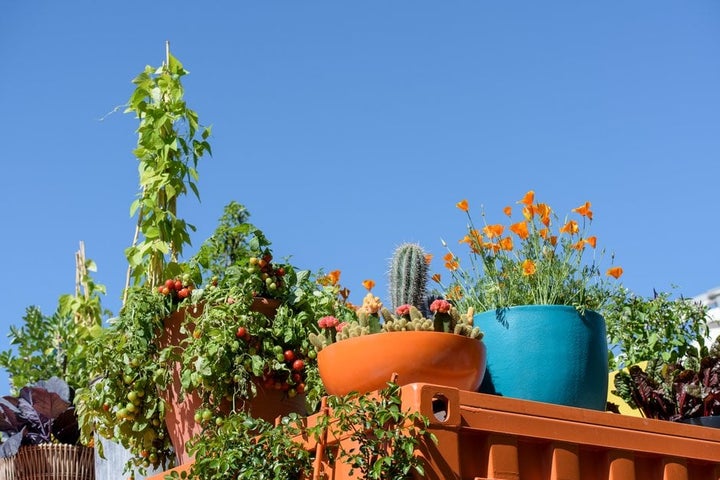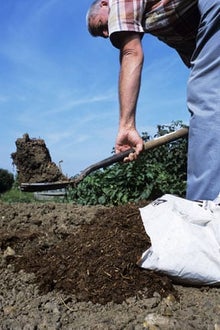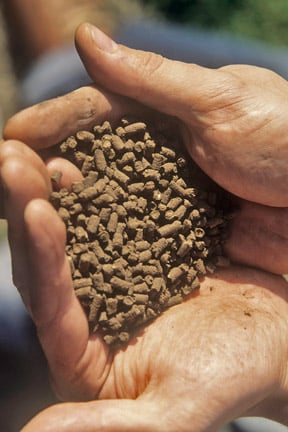
Quick facts
The majority of ornamental plants, especially established trees and shrubs, don't need feeding
Feeding may be needed in some instances, such as for crops, seedlings and plants in containers
Organic mulches feed soil, improve soil structure and conserve soil moisture
Using your own garden compost as a mulch is an environmentally friendly way to feed your soil
Do plants need feeding?
You probably don’t need to do much regular feeding in your garden. Improving garden soil is the best way to grow great plants, but fruits and vegetables and plants in containers usually need some feeding (see our guide to What plants need feeding and when? below). If in doubt, only use a fertiliser when you know your plant is missing specific nutrients – often seen as poor growth and discoloured leaves. See our page on fertilisers for more information on the different types of fertilisers and their uses.
Buying fertilisers isn't great for the environment. Manufacturing, packaging and shipping all have a carbon footprint. Plus, using too much fertiliser – even natural and organic feeds – can result in water pollution from leaching out of the soil.
Start by feeding your soil
Instead of using fertilisers, try mulching with organic matter. Good mulches to use include homemade , well-rotted manure, manure or plant-based soil conditioners and council compost made from . Overall, go for homemade or locally-produced , as this has less environmental impact.
Aim to apply a 5-8cm layer of mulch to about a quarter of your beds and borders each spring. You don't need to mulch everything every year.
Mulch is a good source of plant nutrients. As the mulch breaks down, it releases stored and helps soil microbes, including beneficial mycorrhizal fungi, which all help plants thrive. While mulch doesn't have as many concentrated plant nutrients as fertiliser, you apply a lot, so you probably won't need to use fertiliser.

Home composting is a great way to turn your garden waste into mulch. Mulching with homemade compost is one of the most sustainable ways of improving soil and feeding plants.
What plants need feeding and when?
Improving the soil will help many plants in your garden. However, there are some specific cases where you might need to feed. Here’s our guide to help you prioritise which plants to feed to get the best results:
1. Plants showing signs of nutrient deficiencies
When you see plants with yellow or purplish discolouration between the leaf veins, it is likely to be a nutrient deficiency. Try to establish which deficiency the plant has by looking at our guide to nutrient deficiencies. This guide also explains which fertiliser to apply to remedy a deficiency.
2. Feeding seedlings and cuttings
Give young grown in peat-free compost a feed once they have developed their first leaves, and feed when they start to grow. Ideally, use a high nitrogen (N) and low potassium (K) feed, such as Elixir Gardens High Nitrogen Liquid Plant Food (20-0-10), but using a liquid general-purpose feed will still help. Be sure to read the fertiliser label and use the recommended dose.
3. Feeding plants in containers
Feed plants in containers about six weeks after planting, as the start to run out. Plants often grow okay without much feeding, so add the minimum amount of feed to get the quality of plant or crop you want (see How can I reduce the need to feed containers? below).
During the growing season (April to September), give containers a liquid feed with an organic fertiliser (such as seaweed) or a homemade feed (such as nettle and comfrey). Follow the guidance below for different plant groups:
- Fruits and vegetables (tomatoes, cucumbers, etc.) – every two weeks with a liquid feed, or weekly if using homemade feed.
- (petunias, cosmos, etc.) – three or four times over summer with a liquid feed, more regularly if using homemade feed.
- Ornamental plants (trees, shrubs, , bamboo) – once a month with a liquid feed.
- Ericaceous plants (blueberries, camellias, etc.) – once a month with a liquid ericaceous (acid-loving) feed or seaweed feed with added iron.
Check fertiliser labels as instructions can vary.
4. Feeding houseplants
Houseplants rely on feeding for healthy growth as they have limited from which to get their nutrients.
- Foliage houseplants benefit from a liquid general-purpose or houseplant feed once or twice a month from March to October.
- Orchids need a liquid specialist orchid feed throughout the year.
- Cacti and succulents benefit from a monthly application of a liquid houseplant or specialist cacti feed from April to September.
5. Feeding fruits and vegetables in the ground
with organic matter can deliver all, or most, of the nutrients fruits and vegetables need to give you plentiful crops. Use the no-dig method and apply a 5cm layer of each year (or at least once every three years).
You can also use plants to boost your soil fertility. Sow or plant legumes such as peas and beans sold as green manures. Growing green manures prevents nutrients being washed away by rain and adds nitrogen to the soil.
If you garden on sandy or chalky soil, or grow heavy feeders like brassicas, you may need to apply fertiliser. If crops don’t grow well, use homemade or organic fertilisers, such as seaweed or comfrey liquid feeds, to minimise environmental impact.
6. Feeding lawns
Most lawns grow perfectly well without feeding. Even lawns that turn brown in dry summers or suffer in wet winters usually recover, particularly with help from autumn lawn care, including scarifying, and overseeding.
If you still need to boost your lawn, use a feed. Choose an organic, pelleted or granular lawn feed, as these have less environmental impact. Follow the recommended dose and time of application.
How can I reduce container feeding?

Want to spend less time feeding your potted plants and be more environmentally friendly? Here are our tips:
- Choose low-maintenance plants: Some plants don't need much feeding, like ornamental grasses, drought-tolerant shrubs, and Mediterranean herbs.
- Make your own potting : It should provide enough in the first growing season, unless you're growing heavy-cropping fruits and vegetables. See our guide to making your own potting mix.
- Boost your potting compost: Mix organic fertiliser into your potting mix before planting. You can also scatter it on top later (known as top dressing).
Problems with feeding
You won't encounter many problems with feeding if you stick to the instructions on the products you use. However, here are some potential issues you can avoid:
- Leaf scorch: Avoid getting fertiliser on plant leaves. Spread granular feeds around the base of the plant. Only apply foliar feeds directly to leaves.
- Overfeeding: Nitrogen-rich fertilisers particularly encourage lush growth, which can make plants less resilient to poor weather. The lush, softer growth is also more susceptible to pests and diseases.
- Late-season feeding: Don't fertilise late in the year, after September. The new growth won’t toughen up before winter and may be damaged by cold weather. This applies to high-nitrogen lawn fertilisers too.
- Soil health: Too much fertiliser can harm beneficial soil microbes including mycorrhizal fungi, which are important for plant health.
- Compacted soil: If your soil is hard and compacted, fertiliser might not work well. Loosen the soil with a fork before fertilising.










